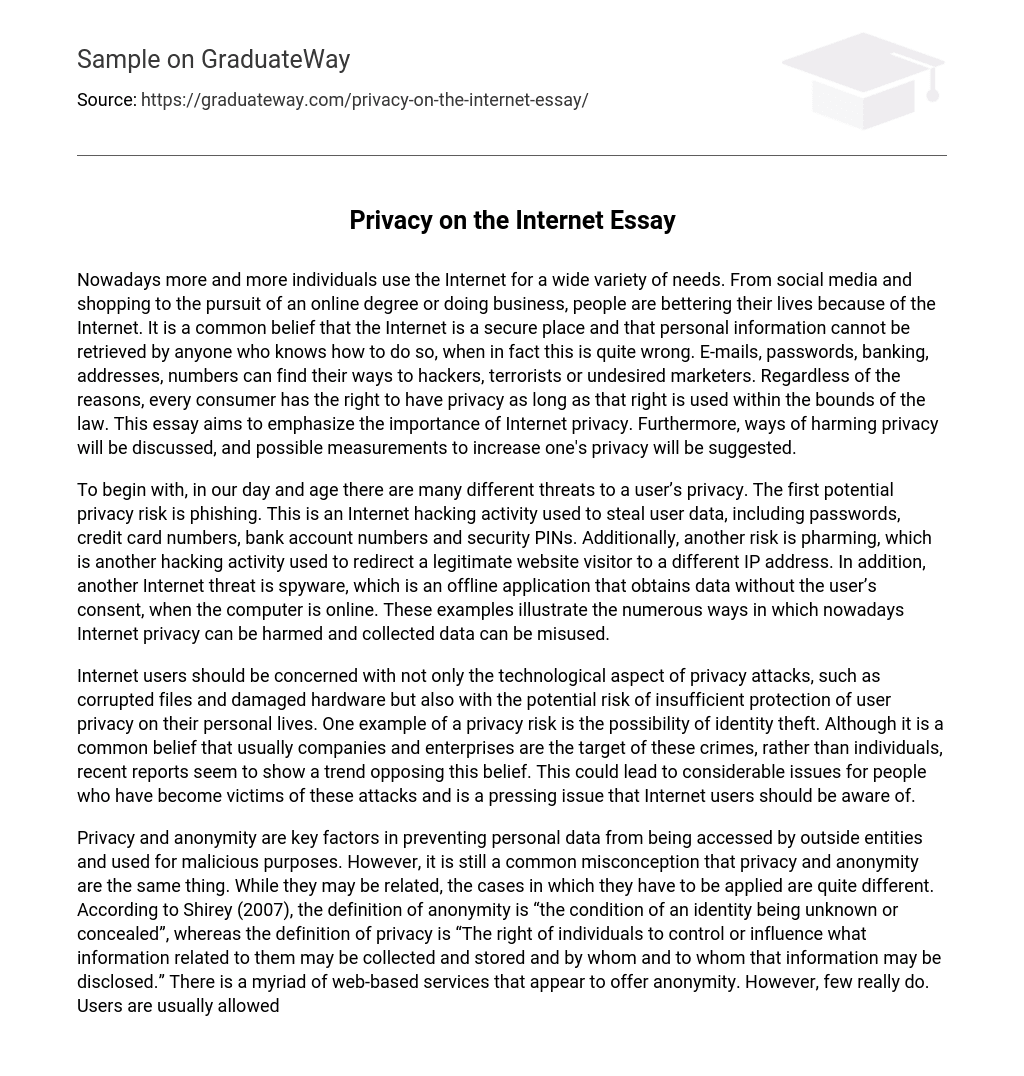Nowadays more and more individuals use the Internet for a wide variety of needs. From social media and shopping to the pursuit of an online degree or doing business, people are bettering their lives because of the Internet. It is a common belief that the Internet is a secure place and that personal information cannot be retrieved by anyone who knows how to do so, when in fact this is quite wrong. E-mails, passwords, banking, addresses, numbers can find their ways to hackers, terrorists or undesired marketers. Regardless of the reasons, every consumer has the right to have privacy as long as that right is used within the bounds of the law. This essay aims to emphasize the importance of Internet privacy. Furthermore, ways of harming privacy will be discussed, and possible measurements to increase one’s privacy will be suggested.
To begin with, in our day and age there are many different threats to a user’s privacy. The first potential privacy risk is phishing. This is an Internet hacking activity used to steal user data, including passwords, credit card numbers, bank account numbers and security PINs. Additionally, another risk is pharming, which is another hacking activity used to redirect a legitimate website visitor to a different IP address. In addition, another Internet threat is spyware, which is an offline application that obtains data without the user’s consent, when the computer is online. These examples illustrate the numerous ways in which nowadays Internet privacy can be harmed and collected data can be misused.
Internet users should be concerned with not only the technological aspect of privacy attacks, such as corrupted files and damaged hardware but also with the potential risk of insufficient protection of user privacy on their personal lives. One example of a privacy risk is the possibility of identity theft. Although it is a common belief that usually companies and enterprises are the target of these crimes, rather than individuals, recent reports seem to show a trend opposing this belief. This could lead to considerable issues for people who have become victims of these attacks and is a pressing issue that Internet users should be aware of.
Privacy and anonymity are key factors in preventing personal data from being accessed by outside entities and used for malicious purposes. However, it is still a common misconception that privacy and anonymity are the same thing. While they may be related, the cases in which they have to be applied are quite different. According to Shirey (2007), the definition of anonymity is “the condition of an identity being unknown or concealed”, whereas the definition of privacy is “The right of individuals to control or influence what information related to them may be collected and stored and by whom and to whom that information may be disclosed.” There is a myriad of web-based services that appear to offer anonymity. However, few really do. Users are usually allowed to create a personal username that they use for accessing their accounts or sending messages. Unfortunately, through log-in and sign-up procedures, it is surprisingly simple to determine a user’s IP address, and even their true identity, when they use these services. This example shows us the potential threat hidden in something as simple as accessing a profile that people nowadays do daily. Therefore a deep understanding of data protection is crucial for all Internet users.
Fortunately, the risk of Internet privacy violation can be minimized. There are plentiful means available to protect one’s online privacy. Some of them are large and complex while others are extremely simple. One method to increase Internet security is to use preventative software applications, such as anti-virus and anti-spam. Another way to reduce the risk of Internet privacy violation is data minimization. “Data minimization refers to collecting, using, disclosing, and storing the minimal data necessary to perform a task. Reducing the amount of data exchanged reduces the amount of data that can be misused or leaked. Data minimization can be effectuated in a number of different ways, including by limiting collection, use, disclosure, retention, identifiability, sensitivity, and access to personal data.” as stated by Cooper et al. (2013) is the most straightforward method to minimize privacy risks. Moreover, another way to oppose Internet privacy threads is for the user to always use strong passwords and to choose different passwords for every application. As long as one is aware of the threats, there are myriad ways for protection.
In conclusion, Internet privacy should not be taken lightly. Most of the Internet users believe that the cyberspace is a secure place and are not fully aware of possible privacy violations such as phishing, pharming and spyware. There are plentiful methods available to protect one’s online privacy such as to use preventative software applications or data minimization among others. The first step of the process of minimizing Internet privacy violations is to understand the huge risk that Internet users are put at and the importance of online privacy.





